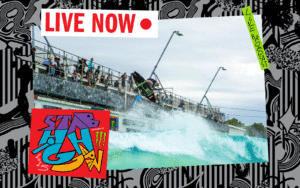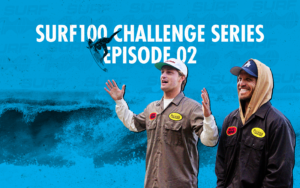Stab’s Isolation-Inspired One-Board Central American Quiver
Introducing the Chem Zen3.
Imagine it’s the apocalypse.
Or rather, imagine it’s right now, but instead of being barricaded in your first-world home behind a wall of toilet paper and Febreeze, you’re posted somewhere deep in the Central American jungle, surrounded by monkeys and mosquitoes and terribly fun beach breaks, ranging anywhere from one-to-six feet.
Now imagine that you’ve only got one surfboard, and with borders closing around the world, no idea how long you’ll be stuck there.
What board would you choose?

Pick a board, any board!
Having sampled a wide range of boards in Central America as a part of the Joyride series, I feel uniquely qualified to answer this question.
The CI Happy and Eye Symmetry Lucid Eye would be best for the pumping days.
The Holy Grail and Cymatic would be best for rippable, mid-sized surf.
The JS Black Barron and Forrest Minchinton twinnies would be best for when it’s small and/or mushy.
But what’s the board that performs best across all conceivable conditions? Well, you’d be hard-pressed to find something more adaptable than the Chemistry Zen3.

Short, wide, a little cushion for the pushin’, channels and a five fin setup. What doesn’t the Zen3 have going for it?
First thoughts: looks a bit fishy, right? Kinda like a groveler…
Well, you’re half-right.
I spent the holidays in Costa Rica’s north, and January is a notoriously flat month for the South Pacific. When I say the waves were a maximum of one-foot on New Year’s Eve, that is not some Hawaii-inspired flex. I mean a very literal, Florida-style one foot. The type of wave that slaps an average man’s knee or my bellybutton.
Tiny, gutless, borderline unsurfable. But it was the last day of the decade, I was a little tipsy from day drinks on the beach and wanted to catch a wave before the world burned (little did I know how true this prophecy would become). So I waxed up the Zen3 and paddled past a few ex-pat dads pushing their three-year-olds into shorebreak rollers.
“Bit keen, don’t ya think?” said one dad, Aussie, with a cheeky grin.
I laughed, half-embarrassed.
“Had to see if it was possible…”
Three successful, surprisingly fun rides later, and the Aussie dad was ditching his kid on the beach and paddling out on the 7′ foam-board himself.
I laughed again as he approached the lineup, this time more confidently.
“It doesn’t take much to convince me,” he chuckled, and before turning on a shin-high runner and surfing it gracefully to the shoreline.
Two takeaways here:
-
The Chem Zen3 can surf the smallest waves imaginable for a board under six feet.
-
Find an Aussie at any lineup in the world, and even if he’s riding his kid’s 7-foot foamie, he’ll probably be the best one out there.

Not the day in question, but not much bigger, either.
Photography
Ana Victoria
Sure, this board can grovel, but here’s the thing about the Zen3—it’s actually designed for heavy, hollow surf.
Surprised? So was I, until I considered the following:
The Zen3 has a relaxed entry rocker and tons of forward volume for paddling, four channels on the bottom for speed and control, and a shortened outline that makes negotiating small-ish tubes a dream.
And while the wide thumb-tail mightn’t be a traditional tube shape, it has the unique benefit of allowing for widely-spaced quad fins. The large gap between the trailers equates to more overall speed, which is always your friend in run-n-gun surf.
This all sounds great on paper, but then so did Enron.
In order to verify its abilities (or at least that it wasn’t a Ponzi scheme), I had to sample the Zen3 in dumpy beachbreak tubes. Luckily, I knew just the place.
The following took place in a 30-minute window of frivolity before the wind came up and turned it to cheddar.
Please excuse the production quality, it took every ounce of my iMovie skills to make it look even this good.
Takeaways: for a board that’s several inches shorter than me, the Zen3 paddled extremely well. It wasn’t the most adept at knifing drops, probably because it’s thick in the rails and generally wide, but once you’d set your rail it was off like a Roman candle. Super-fast with great lateral mobility.
Also, it’s worth talking about fins.
In my opinion, the Zen3 is best suited to a quad setup due to its short outline, wide tail, and preferred wave types (tiny burgers and dumpy tubes). However, when I rode the board as a quad, it was difficult to control backside. As a thruster, it was more reliable but seemed to go about 30% slower.
Like almost anything in life, you’ve gotta give to get. And I’ll forfeit every stupid left for the chance to fly on my forehand. So quad fins it is.

Feel the rhythm, feel the rhyme!
Photography
Ana Vic
We now know that the Chem Zen3 can tackle small, gutless surf and thumping tubes, but how would it fare in Central America’s typically middling, rippable conditions?
After sampling the board in a number of chest-high, well-shaped waves, I’d say it presents right around average.
By looking at the Zen3, you can tell it’s not gonna be some wild high-performance craft, but it got the job done both off the lip and on the rail. There were some occasional slide-outs and bogs—particularly when trying to turn hard in a cupped-out section—but when I remembered to slow everything down and carve a bit more gingerly, the Zen3 flowed beautifully.
Now, an overall assessment:
As both a groveler and a tube board, the Zen3 is an 8.
As an everyday shooter, a 5.
That makes its average score across all three sections of the Central American surf criteria a flat 7.
That number might not have you jumping out of your seat, but think about this logically: is there a board in your quiver that would score similarly or higher across such a broad spectrum of conditions?
I’ve ridden a fair share of brands and models over the past couple of years, and if you told me I could only use one of them for my next few months of isolation, the choice would be clear.














Comments
Comments are a Stab Premium feature. Gotta join to talk shop.
Already a member? Sign In
Want to join? Sign Up